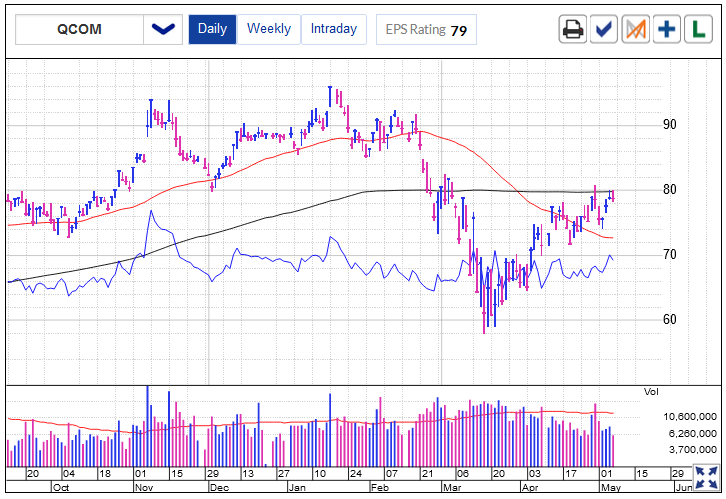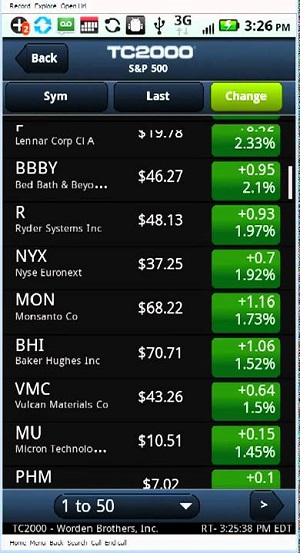
Qualcomm CEO Steve Mollenkopf Drives Worldwide 5G Growth By Investors Business Daily
Steve Mollenkopf has seen it all during his decadeslong career at Qualcomm. But the Qualcomm CEO always focuses on what’s next.
The company’s position powering the world’s mobile technology, based on silicon chips and patents, seemed unassailable when he became Qualcomm CEO in March 2014. Since then, his unique style helped him work through a barrage of challenges.
Prior to him taking over, Chinese regulators questioned its fees to customers. But Qualcomm settled this in February 2015. Then Korean and European authorities and the U.S. Federal Trade Commission challenged its practices. Apple its biggest customer, and Chinese giant Huawei Technologies refused to pay. Some shareholders tried to split the company. And Broadcom staged an unsuccessful hostile takeover bid.
But through all this, Mollenkopf focused on the key thing for a technology company: future products. Being a major player in next-generation 5G wireless technology is essential.
“I told our employees not to be distracted by the noise, since we would continue to invest in innovation, drawing on our collective brain and continuing to communicate with everyone involved,” Mollenkopf told Investor’s Business Daily. “As a result, we were able to deliver 5G a year ahead of schedule, which last April resulted in a new agreement with Apple.”
Qualcomm CEO: Create A Culture of Rebels
Mollenkopf, 51, grew up in Baltimore. He earned a B.S. in electrical engineering at Virginia Polytechnic Institute, where he played lacrosse. It’s a fast-paced sport that can be rougher than football. After receiving a master’s degree at the University of Michigan in 1994, his older brother showed him a job ad for Qualcomm. Mollenkopf moved to San Diego, where Qualcomm is headquartered, and he began moving up the organization.
Electrical engineers who wanted to create better mobile phones founded the company (whose name stands for “quality communications”) in 1985. Its code division multiple access (CDMA) is a radio transmission technology.
CDMA expanded the ability to handle 10 times the number of calls in the same spectrum as the primary competitor, Time Division Multiple Access (TDMA). Qualcomm received its first CDMA patent in 1987.
But when TDMA was adopted as the national standard in 1989, everyone thought the company was finished. Employees pushed ahead anyway, working hard with the conviction the best tech would win.
“We’ve been called rebels, risk-takers, pioneers, and geeks because we dream big and invent bigger, creating breakthrough technologies that transform how the world connects,” Mollenkopf said.
Champion Long-Shot Innovation Like The Qualcomm CEO
In 1990, Qualcomm won research funding from network operators and equipment vendors. And the next year it had an initial public offering. By 1995, most U.S. networks adopted CDMA.
But no one wanted to make the handsets, chips, or network infrastructure. Qualcomm decided to do this itself. It issued another 11.5 million shares for $486 million and had sales of $383 million that year to launch. Three years later, it spun off the handset unit to concentrate on licensing patents (now the Qualcomm Technology Licensing or QTL operating segment) and making chipsets (Qualcomm CDMA Technologies or QCT segment).
Mollenkopf served as vice president of engineering at QCT between 2002 and 2006. And he was senior vice president of engineering until 2008. High-risk assignments lured the future Qualcomm CEO. He spent much of his time developing projects that were not the immediate focus of the company.
“You need to do the things you’re assigned, even if it’s not one of the glamorous must-do projects, because you don’t have the insight to know what’s going to help your career,” Mollenkopf said.
Let Technology Gurus Influence Business Decisions
Giving employees closest to technology a strong voice in the business is essential, says the Qualcomm CEO.
“We play in a rough gym and if we make big mistakes we won’t survive, so there is always enough tension that hopefully the staff can pare down the list so the CEO can prioritize the best ideas,” he said. “But there were times when my team had to ignore the negative things some in management were saying about what we were working on.”
One of those projects was developing chips in 2G and 3G for Wideband CDMA. Other countries preferred these technologies. Going after these ultimately expanded the company’s market. He also advocated combining cellular modems with computer processors on a single chip. That move became today’s Snapdragon semiconductors, used in many Android phones. Today, Mollenkopf has 38 patents of his own.
From 2008 to 2011, Mollenkopf headed efforts in QCT. The unit developed ultra-mobile wideband. But Mollenkopf championed a shift to LTE radio technology. He oversaw acquisition of Atheros for $3.1 billion. Qualcomm rose as the largest mobile chipset supplier in the world. Just in time for 4G’s launch.
Stay Focused Like The Qualcomm CEO During Turmoil
In the 2005 to 2009 period, Mollenkopf directed innovation in 3G and the development of 4G. Mollenkopf and his team also dealt with legal and financial disputes with regulators, rivals, and customers. Preparation for those issues would guide Mollenkopf a decade later as Qualcomm CEO.
“I’ve been lucky to have been given a lot of assignments early in my career that I probably should not have had because the company was growing so fast, so my success in those gave me confidence in what we are doing,” said Mollenkopf.
“That’s what I call positive stress because you feel more in control of the outcome. I’ve also worked with people who hate to lose, and we’re motivated to do the right thing even in the face of criticism, so we put our foot on the gas pedal for innovation in the middle of both periods of outside pressures.”
Mollenkopf’s well-known capacity to stay calm stems from his ability to compartmentalize. “My family doesn’t treat me like a CEO and home is a refuge where I can recharge,” he said.
“I also like to read military history, which teaches you just how much can go wrong and how easy it is to overreact to what may be a minor problem because uncertainty is uncomfortable,” he said. “Often, it’s better to let things play out and wait to make the right decision when you have perspective.”
Leverage Strengths For The 5G Wireless Future
By mid-2019, most of the legal and competitive turmoil was behind Qualcomm. But 5G’s launch neared. A study showed over the next 15 years it would generate $13.2 trillion in global economic growth and result in the creation of 22 million jobs.
Qualcomm’s foundation for the next technological revolution rests on 140,000 patents approved or pending. These cover not only cellular, but radio frequency, connectivity, imaging, power, software, multimedia, processing and other areas.
“I think people will be surprised at the degree to which 5G will disrupt markets beyond cellular,” he said. “Every big industry will be impacted, from health care and automotive to logistics, and we will be aggressively expanding the funnel of demand for our services.”
The challenges are not entirely over. Qualcomm awaits decisions from the Federal Trade Commission late this year or next, and the dispute with the Korean Fair Trade Commission is still not settled. Discussions continue with Huawei.
“Most successful innovators are pragmatic visionaries,” said Alex Goryachev, author of “Fearless Innovation.” “They fearlessly create and shape the future by building and leading the ecosystem. Most importantly, they drive win-together outcomes by welcoming diverse views and creating opportunity for all stakeholders — employees, customers, partners and the community,” he said. “Steve Mollenkopf is a perfect example of that.”
Qualcomm CEO Mollenkopf’s Keys
- CEO of Qualcomm, whose patents and silicon chips power most of the world’s mobile communications technology.
- Overcame: Attempts to violate Qualcomm’s patents and thwart its innovation.
- Lesson: “Your team, if you listen to them properly, will keep you from doing something really stupid.”
Best Electronics Computer Tech Gadgets
TC2000 Trading Software for Smartphones Tablets Computers
HYCM London Stocks Forex Gold Indicies Energy Commodities Bitcoin Broker
Technology Development Online Courses





